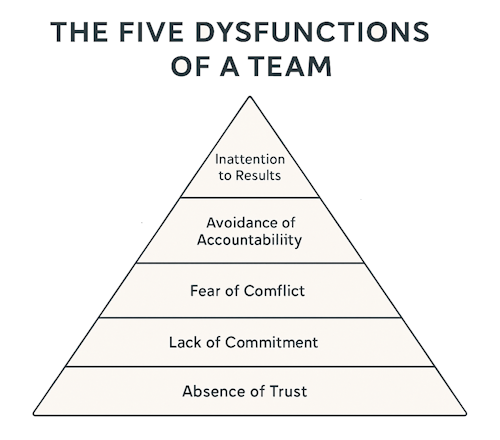Five Dysfunctions of a Team
Highlights core breakdowns in team trust, conflict, and accountability.
"Teamwork begins by building trust. And the only way to do that is to overcome our need for invulnerability." 1
Patrick Lencioni's model The Five Dysfunctions of a Team provides a powerful lens through which to evaluate the common behavioral pitfalls that undermine teams. Rooted in organizational psychology and behavioral dynamics, the model outlines a cascading set of dysfunctions that, if left unaddressed, can erode trust, cripple collaboration, and stall progress. For Agile teams, which depend on high levels of transparency, mutual accountability, and iterative feedback, these dysfunctions can be especially damaging. Agile values like openness, respect, and commitment hinge on cohesive team dynamics, making this model highly relevant for Agile coaching and facilitation.
Impact
The five dysfunctions are stacked in a pyramid, where each level supports the next. When one is present, it tends to enable the others above it. This structure reflects how small cracks in team health can grow into systemic failure.
- Absence of Trust:
- Team members conceal weaknesses and mistakes.
- Reluctance to be vulnerable limits collaboration and learning.
- Fear of Conflict:
- Artificial harmony replaces productive debate.
- Difficult issues are avoided, leading to poor decisions.
- Lack of Commitment:
- Ambiguity persists after meetings.
- Individuals hedge bets or pursue private agendas.
- Avoidance of Accountability:
- Peer-to-peer feedback is rare or uncomfortable.
- Underperformance or misalignment goes unchecked.
- Inattention to Results:
- Team goals are secondary to personal or departmental success.
- Focus shifts from outcomes to internal politics or individual status.

Scenario
An Agile team was struggling with delivery despite having skilled professionals and a clear backlog. Over several Sprints:
- Engineers hesitated to speak up in planning when they had doubts about the estimates.
- Retrospectives became repetitive with no meaningful change.
- One Product Owner pushed hard for deadlines, but others quietly disengaged.
- Missed Sprint Goals were excused rather than explored.
- Leadership noticed churn and rising finger-pointing.
Behind the scenes, team members didn't trust each other to handle honest feedback, so they avoided real conversations. The Scrum Master sensed the tension but didn't yet have the psychological safety or coaching leverage to challenge the group norms.
This team's dysfunction wasn't technical, but relational. Without trust, vulnerability, and mutual ownership, they could not adapt as a unit.
Ways to Mitigate:
Coaches and leaders can shift these dynamics with intention and persistence. Interventions should be layered and adapted over time.
- Build Trust:
- Use team liftoffs, personal storytelling, or feedback exercises.
- Model vulnerability as a leader or coach.
- Promote Healthy Conflict:
- Normalize disagreement as progress.
- Facilitate structured dialogues or Liberating Structures.
- Drive Commitment:
- Use clear decision protocols like consent or commitment voting.
- Summarize agreements at the end of meetings.
- Enforce Accountability:
- Build explicit working agreements and review them often.
- Empower peer-to-peer check-ins outside of Retrospectives.
- Focus on Results:
- Make team goals visible and review progress each Sprint.
- Celebrate shared wins and diagnose missed targets together.
Conclusion:
The Five Dysfunctions of a Team framework remains one of the most actionable tools for strengthening Agile teams beyond process mechanics. It reinforces the idea that trust, not tooling, is the foundation of agility. While Scrum or Kanban structures create containers for delivery, this model reminds us that emotional safety and behavioral norms must be deliberately cultivated. Agile Coaches, Scrum Masters, and leaders who focus on these deeper dynamics can unlock performance that sticky notes and Sprint boards alone cannot sustain.
Key Takeaways
- Trust is the foundation for all other team dynamics.
- Fear of conflict leads to artificial harmony and missed insights.
- Without buy-in, teams struggle to commit and follow through.
- Avoiding accountability weakens performance and ownership.
- Personal agendas take over when team goals are unclear or unshared.
Summary
The Five Dysfunctions of a Team model helps Agile practitioners uncover hidden sources of team underperformance. By addressing trust, conflict, commitment, accountability, and results, Agile Coaches can go beyond surface-level metrics to strengthen team cohesion and resilience. This model integrates naturally with Agile principles and should be part of any serious coaching toolkit.